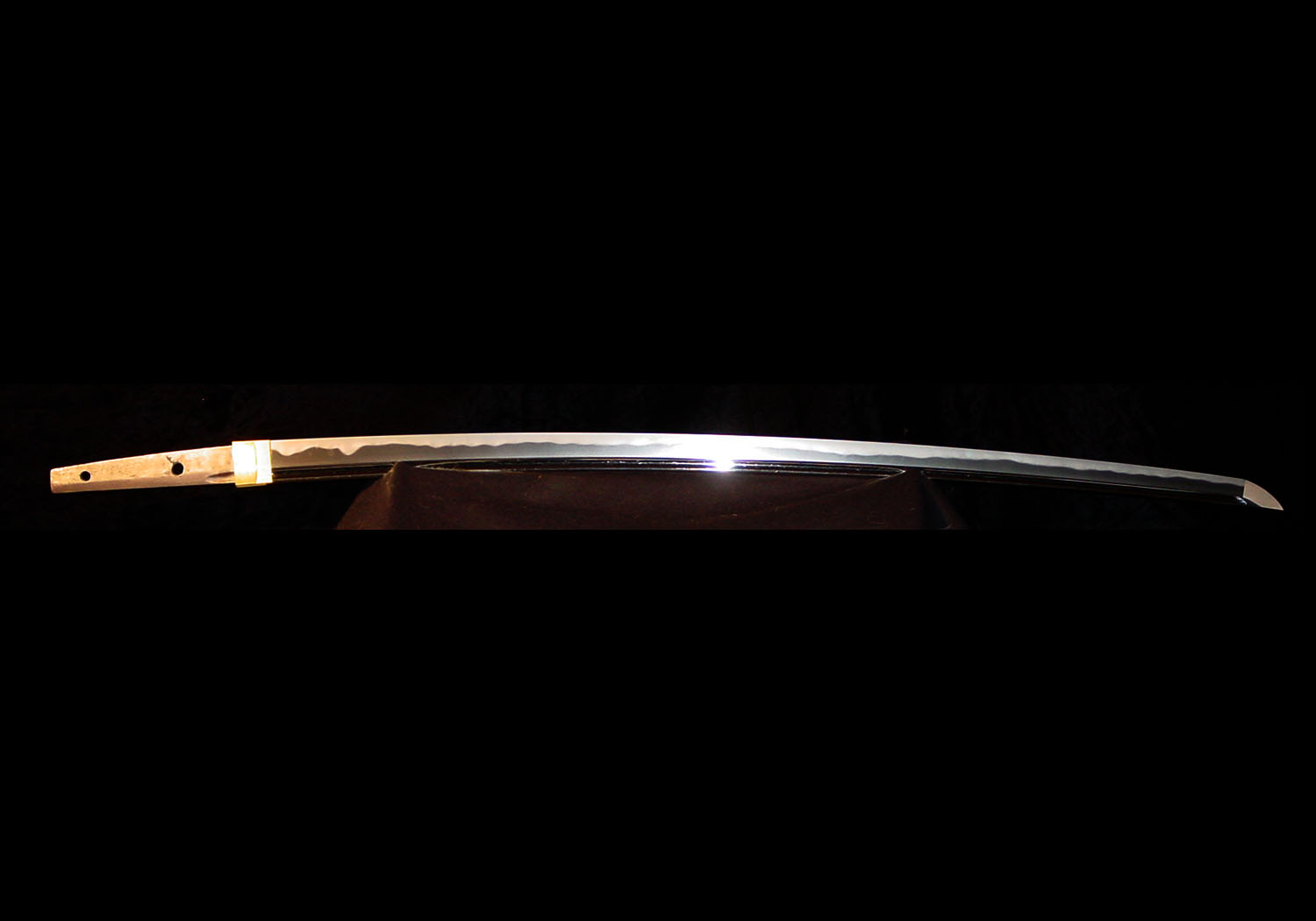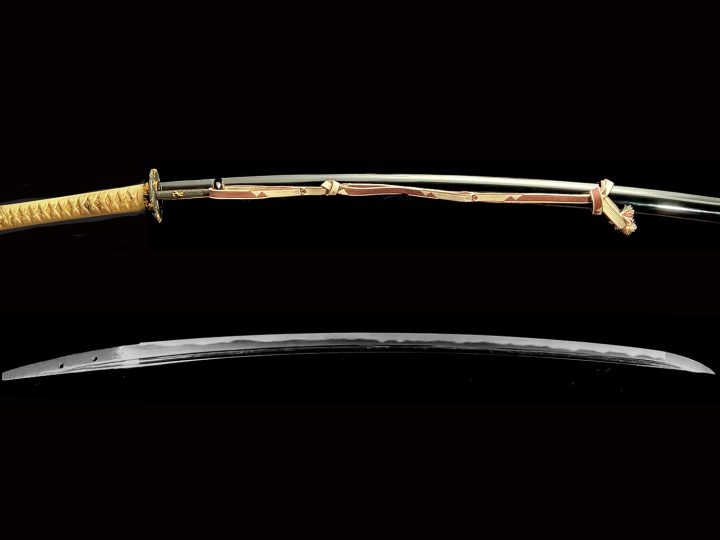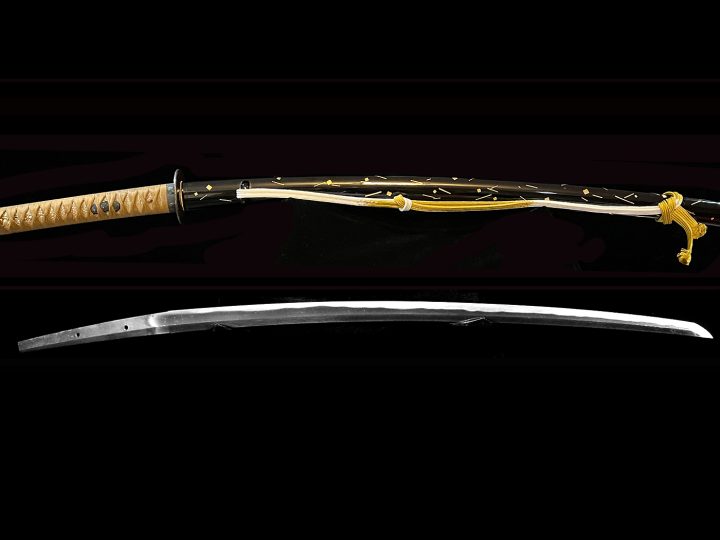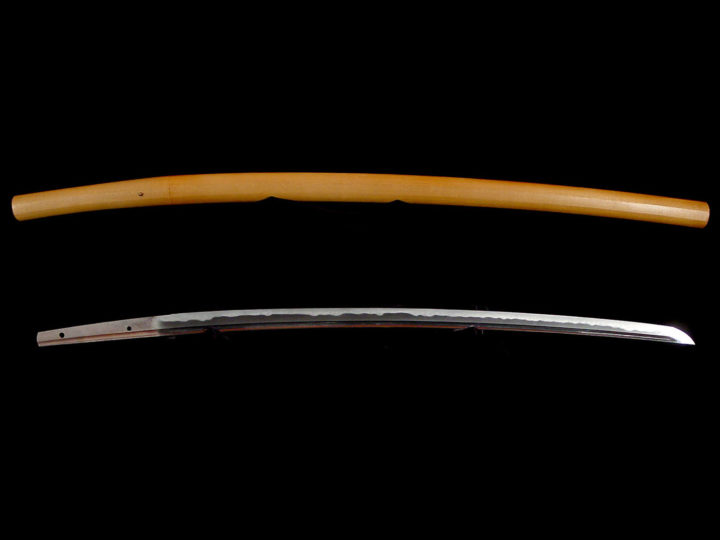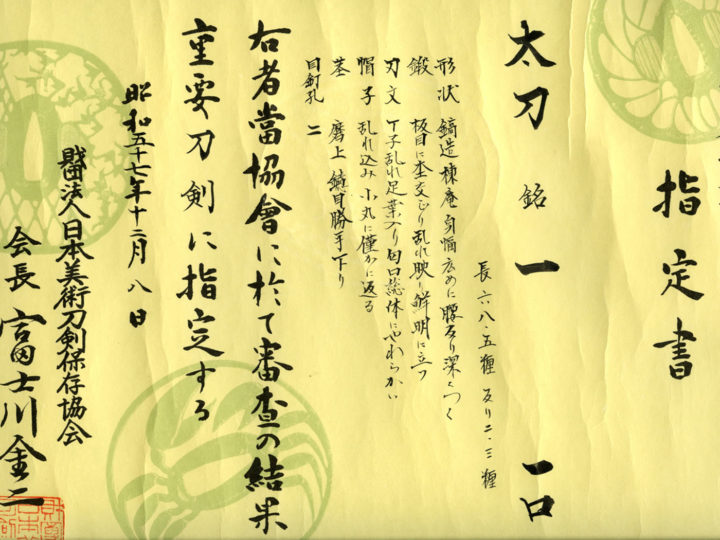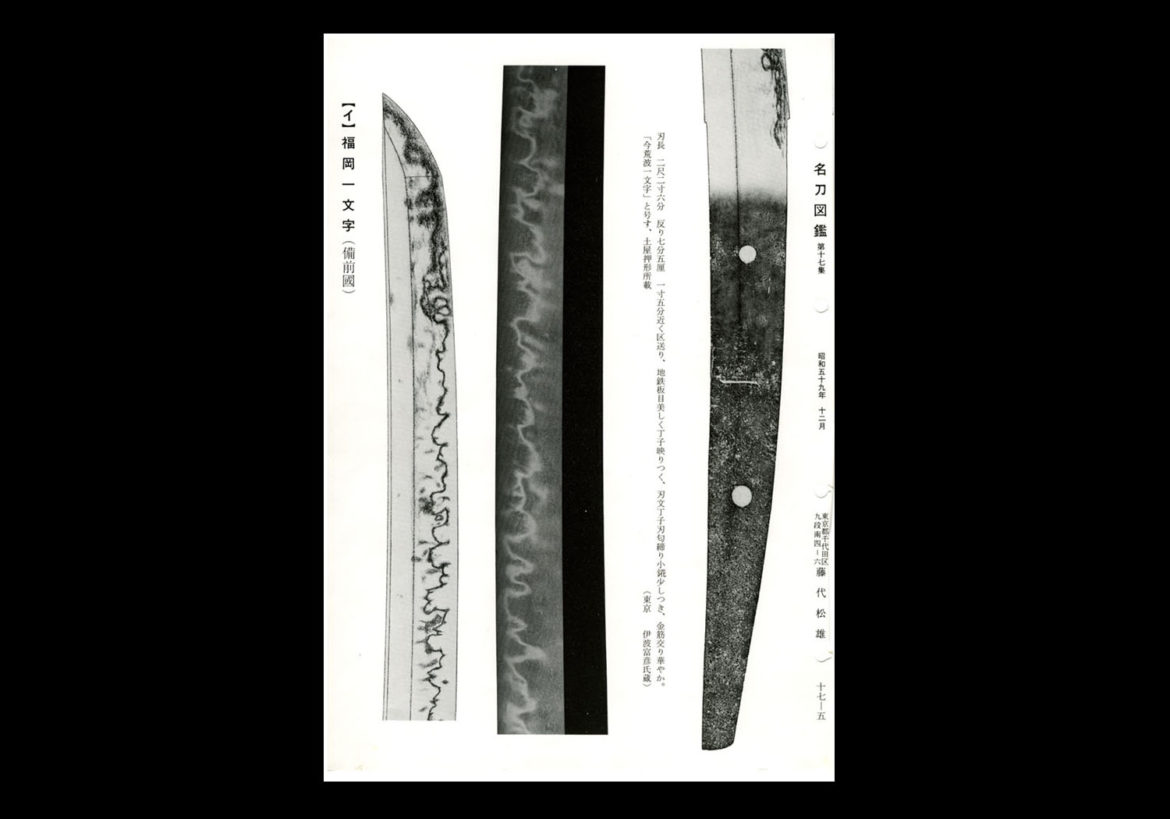
The Ichimonji School (一文字) in Bizen Province was a large school that was founded in the beginning of the Kamakura period and lasted through the Nanbokucho period. From the beginning of the Kamakura period and up until the middle of the Kamakura period, works by this school are commonly referred to as Ko-Ichimonji (古一文字) works. From the beginning of the Kamakura period and through the middle of the Kamakura period, the center of the production done by this school was located in the area called Fukuoka (福岡). From the end of the Kamakura period and through the early part of the Nanbokucho period, the center of production moved to Yoshioka (吉岡). Around the Shochu era (1324-1326) another branch of the Ichimonji school sprang up in Iwato (岩戸) in Bizen. This branch is called the Iwato Ichimonji (岩戸一文字). Since it was most active around the Shochu (正中) era, it is also called the Shochu Ichimonji school (正中一文字). Around 1225, Norifusa (則房) is said to have founded Katayama Ichimonji school (片山一文字) when he moved to Katayama (片山) from Fukuoka (福岡).
The name of the school is derived from the fact that many of the swords extant today are signed only with the kanji character “Ichi” (一). To this day there is uncertainty as to whether any of the smiths who signed with individual names are one and the same as any of these practically anonymous artisans who signed with only an “Ichi” (一).
THE KO-ICHIMONJI SCHOOL (古一文字)
In the early Kamakura period, workmanship of the Ichimonji smiths was classical and subdued. It was close to that of the Ko-Bizen (古備前) smiths but different in certain respects. Smiths from this period are known as the Ko-Ichimonji (古一文字) smiths. The main characteristics of the Ko-Ichimonji school (古一文字) are as follows:
SUGATA: They generally worked in the Yamashiro tradition. Although made in the style and shape of the late Heian period, they are slightly stronger in all respects while still retaining all of the grace and elegance of the Heian period works. They will be slender, have a deep koshi-zori, and ko-kissaki.
JITETSU: They will be well forged with fine ko-mokume hada mixed with o-hada. Jifu utsuri will generally be present.
HAMON: The width of the yakiba will be narrow and done in a ko-chôji midare based on suguha and worked in nioi. There are others that are worked in ko-chôji midare with nie clustering together within the hamon and with the nioi forming deep ashi. In certain works, the width of the yakiba is made wide in suguha chôji worked in nioi and it will have nie worked in. In these works, the grain of the steel will stand out considerably within the hamon. Koshiba is occasionally seen toward the bottom.
BÔSHI: They will be ko-maru, ko-maru sagari, or ko-midare and the kaeri will be short.
NAKAGO: They will be made a little long with the width made narrow towards the end forming a kurijiri tip. Kijimomo will be seen on occasion. File marks, if any, are in kiri or suji chigai.
MEI: When signed, a two character is usual.
THE FUKUOKA ICHIMONJI SCHOOL (福岡一文字)
Norimune (則宗) has long been highly reputed to be the symbolic founder of the Fukuoka Ichimonji School (福岡一文字). His early swords were of the Ko-Ichimonji (古一文字) style that had a modest sori, a nioi based hamon of suguba mixed with ko-midare and ko-choji lined with plenty of nie and embellished with varied nie structures in the ji of hotsure, sunagashi, and kinsuji.
Around the middle of the Kamakura period the shape and workmanship style changed to become more flamboyant with a more robust sugata and large and closely packed choji formations known as juka-choji, o-choji midare, o-busa choji, etc. These are the swords that we commonly refer to as being of the Fukuoka Ichimonji School (福岡一文字).
The notable smiths who followed Norimune (則宗) such as Yoshifusa (吉房), Sukezane (助真), Norifusa (則房), Yoshiiye (吉家), Sukefusa (助房), Nobufusa (信房), Yoshimune (吉宗), and others developed what we today refer to as the Fukuoka Ichimonji (福岡一文字) style. These smiths produced the nioi dominant hamon consisting of o-busa, juka, kawazuka, and kukuro variations of choji-midare tempered in diversified widths and heights. The vivid midare-utsuri in the ji further increases the gorgeous and magnificent quality of their works.
| SUGATA: | The tachi sugata is grand but not excessive, it remains elegant. They are typically shinogi-zukuri, iori-mune with koshi-zori. There will be some funbari ending in a medium sized kissaki in the ikubi style
|
| HAMON:
JITETSU: |
Narrow ko-choji is rare. Typically the hamon will be a robust choji-midare which will be in the form of a combination of juka, kawazuko, gunome, and other variations. The width of the hamon will vary. The predominately nioi structured nioi-guchi is lined with fine ko-nie and contains a great many ashi and yo. Sunagashi, kinsuji, and other forms of nie-based hataraki will be seen.
The kitae is mainly tight itame-hada mixed with mokume-hada. Occasionally a slight amount of o-hada or loose-grained area will be present. There will be pronounced utsuri in the form of choji-utsuri, midare-utsuri, jifu-utsuri or botan-utsuri.
|
| BÔSHI: | The boshi will tend to be somewhat stubby or ikubi in shape. It is midare-komi and in proportion to the hamon and will be either yakitsume or have a short kaeri.
|
| HORIMONO: | Original horimono will not be found with the exception of bo-hi or futatsu-hi. The top of the hi will be sharp and well shaped. The bottom of the hi becomes maru-dome, kaku-dome, or kaki-nagashi. |
THE YOSHIOKA ICHIMONJI SCHOOL 吉岡一文字
From the middle of the Kamakura Era, the Osafune school came into prominence and competed with the Fukuoka Ichimonji school to be the dominant school of sword making in Bizen province. The Osafune school quickly ascended to prominence to the point that people often mistakenly believe that the Ichimonji school was no longer active after the Kamakura Era. The late Dr. Junji Honma of the NBTHK postulated that while the Ichimonji school was the educational foundation for the Osafune school, toward the end of the Kamakura Era the Fukuoka Ichimonji school gradually lost their individual characteristics and finally merged into the Osafune school.
No one, however, disputes that the Ichimonji school branched out around the end of the Kamakura Era when Fukuoka Ichimonji smiths such as Sukeyoshi (助吉) moved to Yoshioka in Bizen Province. Because of this move they thrived much longer than did the Fukuoka Ichimonji smiths and the Yoshioka school continued to flourish well into the Nanbokucho Era.
The swords of the Yoshioka Ichimonji School (吉岡一文字) show workmanship that is magnificent and flamboyant. They followed the fashion of the period in terms of their shape and sugata.
Sugata: The tachi sugata is grand but not excessive, it remains elegant. The width at top and bottom does not vary greatly. Kodachi, nagamaki, and tanto are occasionally seen.
Jitetsu: Itame-hada mixed with o-hada and chikei will be seen. There will be utsuri in the form of choji-utsuri, or jifu-utsuri.
Hamon: The nioi line is tighter than that of the Fukuoka Ichimonji school. Ko-choji midare is mixed with koshi-no-hiraita midare. This is a pattern that is similar to notare with the valleys being gentler than the peaks. It is often mixed, in the upper area, with choji or gunome. Some midare are tapered by nioi or in ko-midare that is inclined to be oblique. Suguha–choji midare is also seen. Koshiba is sometimes tempered at the bottom.
Bôshi: The kissaki will tend to be somewhat stubby or ikubi in shape. The bôshi will be midare-komi and it will often, but not always, have a relatively long kaeri.
Horimono: Except for bo-hi, soe-hi, or futatsu-hi, original horimono will not be found. The top of the hi descend slightly from the ko–shinogi. The bottom of the hi become maru-dome, or kaki-nagashi.
THE KATAYAMA ICHIMONJI SCHOOL 片山一文字
It has often been postulated that Bizen Fukuoka Ichimonji Norifusa founded the Katayama Ichimonji school when he moved from Fukuoka to Katayama in Bitchu Province. Now it is more commonly thought that instead of moving to Bitchu Province, he actually moved to the Katayama that is located not far from Fukuoka within Bizen Province. This move took place in the middle of the Kamakura era around 1225.
Other than Norifusa, the school’s leading smiths include Sanetoshi, Yorizane, Noritsune, and Norizane. These smiths were excellent and their working period extended from the middle of the Kamakura era into the Nanbokucho era.
The Katayama school had its roots in the Bizen Fukuoka Ichimonji style, and because Katayama is close to Fukuoka, the workmanship of the smiths from these two areas is similar. As an example, a typical work of Norifusa will be as follows:
The hamon of Norifusa contains a florid chôji-midare mixed with ko-gunome containing ashi and yô. It is nioi dominated but is lined with ko-nie. There are also sunagashi and kinsuji. The greater part of the hamon is saka-gakaru or slanted. The kitae is a fine ji-nie lined itame mixed with mokume and nagare-masa contains midare utsuri. The boshi will generally be midare stopping in yakitsume style.
Some of the general characteristics of the Katayama Ichimonji school are as follows:
Sugata: Those made in the mid Kamakura era will have a grand and graceful sugata with ikubi kissaki. Examples of tachi with larger kissaki and the other characteristics of the Nanbokucho era will be seen in the works of the later smiths. They made nagamaki as well.
Jigane: Itame hada and mokume hada mixed with o-hada will be seen. Ji-nie and utsuri will be present.
Hamon: The Katayama Ichimonji smiths developed a distinctive hamon of their own. It is based upon the o-choji midare of the Fukuoka smiths but their choji will be in saka design and these are referred to as saka-choji midare. This is the trademark of the Katayama Ichimonji school.
Bôshi: The boshi will tend to be ko-midare and it is inclined to be oblique.
Horimono: The top of the bo-hi ascends toward the ko-shinogi. The end of the hi is usually kaki-nagashi.
Nakago: When ubu they will be not unlike the nakago of the Fukuoka Ichimonji school.
THE IWATO ICHIMONJI SCHOOL (岩戸一文字)
Around the Shochu era (1324-1326) another branch of the Ichimonji school sprang up in Iwato (岩戸) in Bizen. This branch is called the Iwato Ichimonji (岩戸一文字). Since it was most active around the Shochu (正中) era, it is also called the Shochu Ichimonji school (正中一文字). Yoshiuji (吉氏) is said to have founded this school around the Shochu era (1324-1326). The leading swordsmiths of the Iwato Ichimonji school were Yoshiuji (吉氏), Shigeyoshi (重吉), Yoshimori (吉守), Yoshitoshi (吉利), Yoshisada (吉定), and Yoshihisa (吉久). Their work does not have the glamorous qualities of the other Ichimonji schools, but does show some traces of the Yamashiro tradition. Extant works are relatively rare.
Because of the differences in the workmanship between this school and the other Ichimonji schools, some sword scholars feel that it would be more accurate if this school should connected with the Bizen Osafune school rather and the Ichimonji schools.
Some of the general characteristics of the Iwato Ichimonji school (岩戸一文字) are as follows:
SUGATA: Tachi will be made in the style of the early Kamakura era; however there will be very little funbari. The sori will be shallow and there will be little hiraniku.
JITETSU: The jitetsu will be fairly rough mokume mixed with o-hada and some masame hada. If there is utsuri, it will seem “whitish”.
HAMON: The width of the hamon will be made narrow and done in nioi. The pattern will be ko-chôji midare mixed with ko-midare and there will be a tendency for the ashi to be saka (reversed). Suguha mixed with ko-chôji midare will also be seen. There will be small pattern inazuma in areas.
BÔSHI: The boshi will tend to be ko-midare with a slight kaeri.
HORIMONO: Bo-hi, futatsu-bi, etc.
NAKAGO: Made short with the tip in kurijiri. The file marks will be kiri. Mei will be long in many cases, but two-character mei will also be found.







